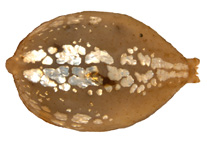Abstract
The diagnoses of Liadytidae Ponomarenko, 1977, Liadytiscinae Prokin & Ren, 2010, Liadytiscus Prokin & Ren, 2010 and Mesoderus Prokin & Ren, 2010 (Dytiscidae) are modified, and the following new taxa are described from Mesozoic fossils: Liadytes aspidytoides sp. n. (Liadytidae); Mesoderini trib. n., Liadyxianus kirejtshuki gen. n. et sp. n., Mesoderus punctatus sp. n., Mesoderus ovatus sp. n., Mesodytes rhantoides gen. n. et sp. n., Palaeodytes baissiensis sp. n. and Cretodytes incertus sp. n. (Dytiscidae). A summarized checklist of all Mesozoic Liadytidae and Dytiscidae known from adults is given, and an identification key to the genera of Mesozoic Dytiscidae known from adults is provided for the first time. Palaeodytes incompletus Ponomarenko, Coram & Jarzembowski, 2005 (the suffix of the specific epithet is emended from the original incompleta) is found to belong not to this genus, but to another one, which remains to be described. The fossil larva Angaragabus jurassicus Ponomarenko, 1963 from the Lower Jurassic of Irkutsk Oblast, Russia, probably belonging to Liadytidae, is re-examined. If this larva actually belongs to Liadytidae, then its morphological characters provide additional confirmation of the conclusion, based on the characters of adult liadytids, that the family is quite separate from the recent family Aspidytidae, and the similarity between the adults of both families results from parallel processes in the evolution of the superfamily Dytiscoidea. We show that the principal trends of morphological changes of Liadytidae and Dytiscidae during the Upper Jurassic and Lower Cretaceous included a consistent increase in the area of the metacoxal plates at the expense of decreasing area of the lateral lobes of the metaventrite ("wings"), flattening and loss of the lateral border of the elevated median area of the metaventrite, and shortening and dilation of the metafemur and metatibia. These changes were probably associated with an increased load of swimming taken by the hindlegs, which required, among other things, the development of swimming muscles attached to the metacoxal plates. The development of the hindlegs allowed diving deeper, thus being an adaptation to the nektonic instead of benthic lifestyle. This is confirmed by the adaptive coloration of the Liadytidae and Dytiscidae found in Shar Teg (Liadytes aspidytoides sp. n.), Yixian (Mesoderus magnus Prokin & Ren, 2010) and Baisa (Palaeodytes baissiensis sp. n.), in which the dorsum was darker than underside, providing camouflage in the depths of the water.

